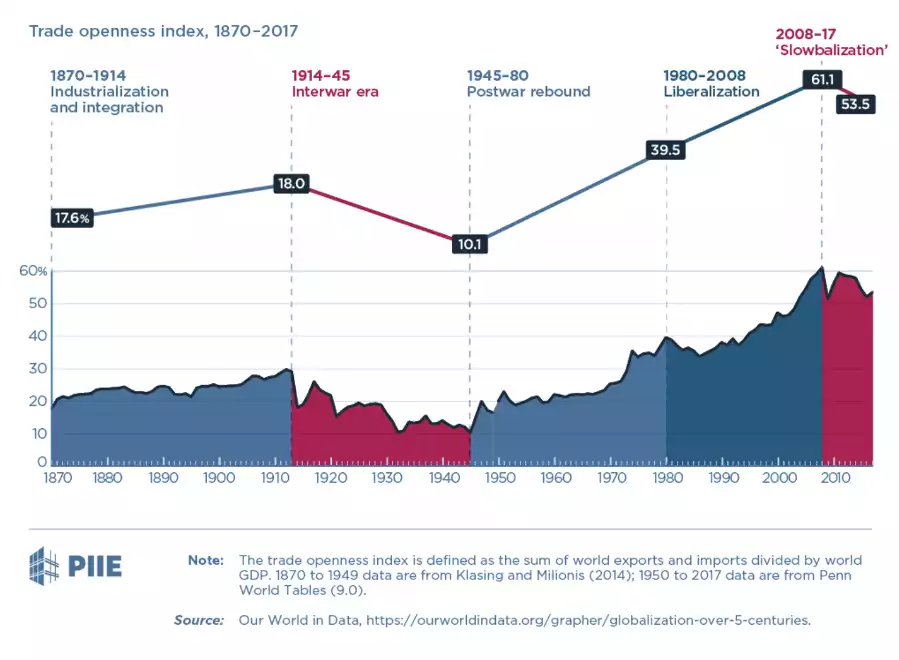Supply Chain Disruptions and ‘Slow-balisation’
News
|
Posted 07/10/2021
|
12297
With gas shortages and price spikes facing UK drivers over the last month being the latest example, societies are undeniably seeing increased supply chain pressures. In the last 18 months we’ve come from expecting international packages to arrive in days, to waiting weeks and months for a book to arrive. Individual consumers and the manufacturers that produce the products we consume have been majorly affected by supply chain disruptions that are seeing globalisation starting to tear at the seams.
Globalisation has seen a convergence of increased trade, capital flows, and cultural exchange as the world becomes increasingly interconnected. The process has been going on for hundreds of years, but has gone into light speed in the last 50, with the internet, mass media and multi-national institutions and corporations growing in prominence.
These trends have hit some major speed humps since March 2020, but the chart below may tell another story.

Globalisation had reportedly reached a peak around the late 2000’s. In fact, many are claiming “slowbalisation” or “de-globalisation” will more accurately reflect the global economy over the coming years thanks to health fears and government decisions around global trade.
Most manufacturing businesses employ a “Just-in-time” (JIT) model, a production system pioneered by Toyota in the 1950’s. The process maximises efficiency and keeps surplus inventory to a bare minimum. Companies sitting on vast amounts of stock can easily run into cash flow problems and then need to discount, eroding margins.
In a globally connected world, this JIT approach has paid dividends for many, but has left producers exposed to delays if even one critical part can’t be sourced. In particular, for operations sourcing inputs from overseas, the last 18 months has been a major headache.
Speaking to CNN, MGA Entertainment CEO Issac Larian has predicted major shortages of toys in the run up to Christmas 2021. “The [shipping container] that cost $3,200 last year is now $22,000. Similarly, Jay Forman, CEO of Basic Fun, has warned: “You’re going to find various times during the holiday season where the store shelves are going to have empty holes in them.”
Even within national borders, supply shortages have had major knock on effects. “Panic buying” has now well and truly entered the vernacular with waves of panic shopping leaving supermarket shelves intermittently bare throughout the Western world. “Prepping” has gone from a fringe idea to a mainstream survival strategy. More and more consumers are looking to stock up on long-life products such as canned food, pasta and frozen meat rather than get caught locked at home for two weeks with only a box of wheat-bix and half a litre of milk for sustenance.
All of this is leading to higher prices for those who are willing to pay them, and a higher cost of living overall.
So where to from here? Recognising these supply chain vulnerabilities, companies are going to increasingly look to secure products closer to home, even if they need to pay slightly more for the piece of mind that that proximity may afford. Rather than Just-in-time approaches, producers may stockpile more base materials and inputs to ensure that any short term disruption won’t be able to turn into a long term one.
This increasing demand has already led to increasing commodity prices from lumber to copper. Silver, as a major industrial metal critical to the production of solar panels, electronic equipment and medical supplies, is still waiting to become the beneficiary of these trends.
Consider too that, as we shared yesterday, the current inflationary pressures are more supply based than demand driven. The abovementioned pressures should see sticky not transitory inflation. In our zero bound interest rate world that means deeply negative REAL interest rates and that too is extremely bullish for both silver and gold.